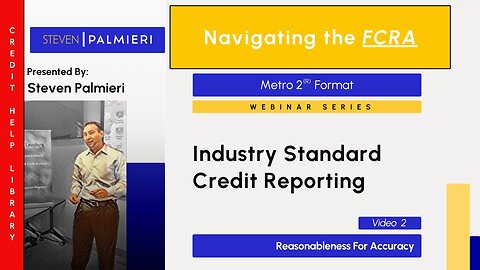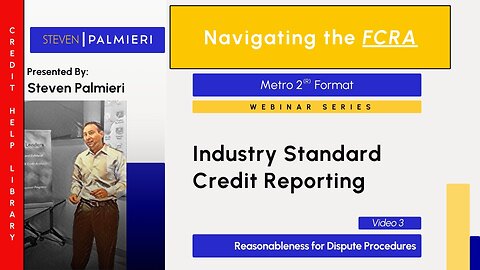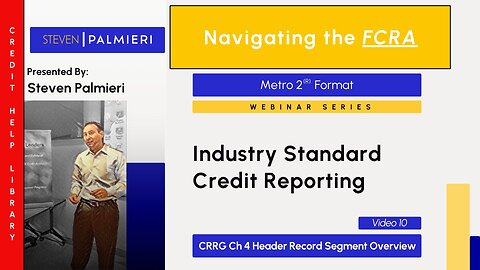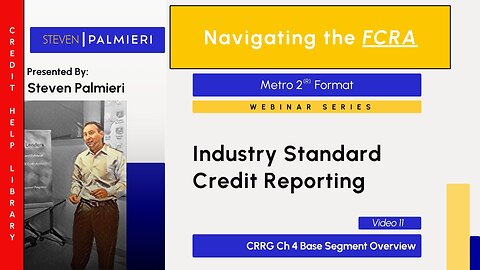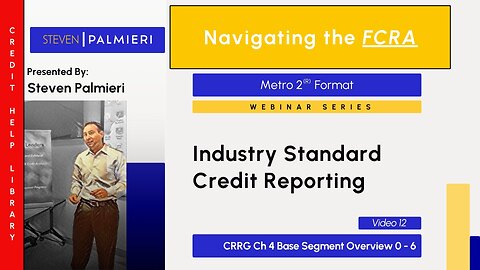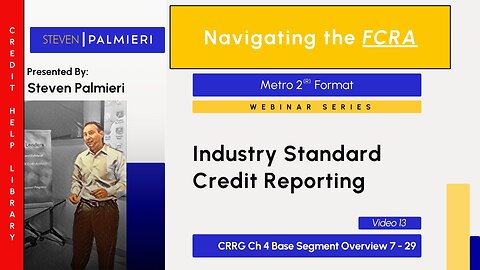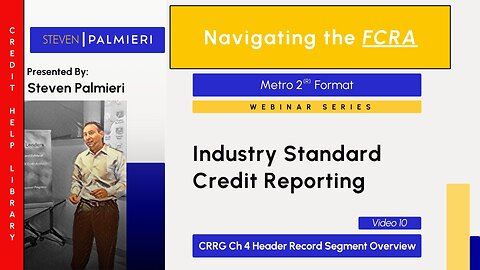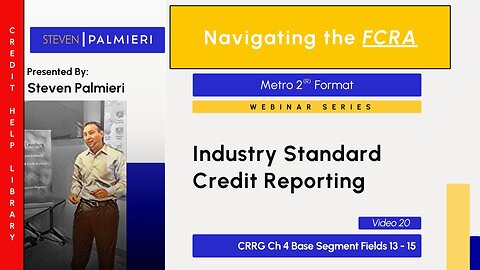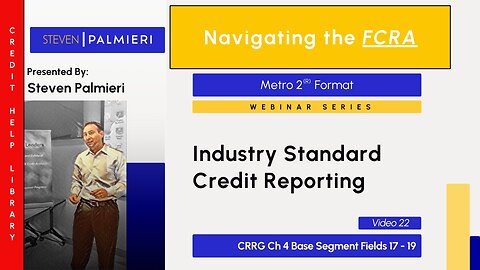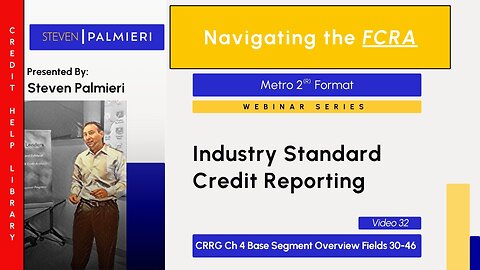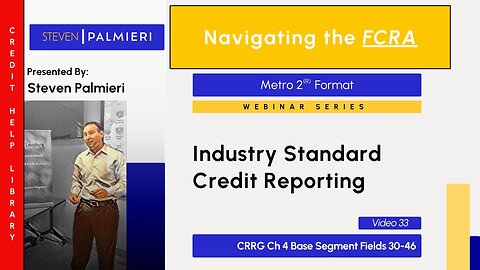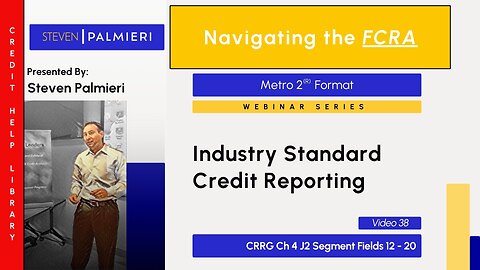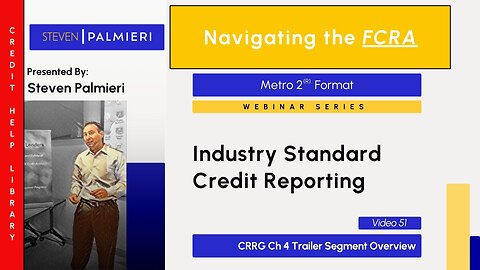Premium Only Content

What is an Industry Standard
Reasonableness for Accuracy
Reasonableness for Dispute Procedures
Metro 2 Table of Contents
Ch 1 Overview
Ch 2 Overview
Ch 3 Overview
Ch 4 Overview
Ch 4 Segment Overview
Ch 4 Header Record Segment Overview
Ch 4 Base Segment Overview
Ch 4 Base Segment Overview Fields 0 - 6
Ch 4 Base Segment Overview Fields 7 - 29
Ch 4 Base Segment Field 7
Ch 4 Base Segment Field 8
Ch 4 Base Segment Field 9
Ch 4 Base Segment Field 10
Ch 4 Base Segment Field 11
Ch 4 Base Segment Field 12
Ch 4 Base Segment Fields 13 - 15
Ch 4 Base Segment Field 16
Ch 4 Base Segment Field 16
Ch 4 Base Segment Fields 17 - 19
Ch 4 Base Segment Field 20
Ch 4 Base Segment Field 21
Ch 4 Base Segment Field 22
Ch 4 Base Segment Field 23
Ch 4 Base Segment Field 24
Ch 4 Base Segment Field 25
Ch 4 Base Segment Field 26
Ch 4 Base Segment Field 27
Ch 4 Base Segment Field 28
Ch 4 Base Segment Overview 30 - 46
Ch 4 Base Segment Fields 30 - 46
Ch 4 J1 Segment Overview
Ch 4 J1 Segment Fields 1 - 12
Ch 4 J2 Segment Overview
Ch 4 J2 Segment Fields 1 - 11
Ch 4 J2 Segment Fields 12 - 20
Ch 4 K1 Segment Overview
Ch 4 K1 Segment Fields 1 - 3
Ch 4 K2 Segment Overview
Ch 4 K2 Segment Fields 1 - 4
Ch 4 K3 Segment Overview
Ch 4 K3 Segment Fields 1 - 4
Ch 4 K4 Segment Overview
Ch 4 K4 Segment Fields 1 - 6
Ch 4 L1 Segment Overview
Ch 4 L1 Segment Fields 1 - 5
Ch 4 N1 Segment Overview
Ch 4 N1 Segment Fields 1 - 9
Ch 4 Trailer Segment Overview
Ch 5 Overview
Ch 5 Exhibit 1 - 2
Ch 5 Exhibit 3
Ch 5 Exhibit 4
Ch 5 Exhibit 5
Ch 5 Exhibits 6 - 7
Ch 5 Exhibit 8
Ch 5 Exhibit 9
Ch 5 Exhibit 10
Ch 5 Exhibit 11
Ch 5 Exhibits 12 - 16
Ch 6 Overview
Ch 7 Overview
Ch 8 Overview
Ch 9 - 13 Summary
Ch 9 Overview
Ch 10 Overview
Ch 11 Overview
Ch 12 Overview
Ch 13 Overview
Ch 14 Overview
Ch 4 Base Segment Overview
The video summarizes the Base Segment overview from Chapter 4 of the Metro 2 Credit Reporting Resource Guide, focusing on its data fields to help readers use the Metro 2 standard to accurately read credit reports, identify errors, and draft dispute letters to consumer reporting agencies (CRAs). Unlike earlier chapters that discussed Metro 2 conceptually—its importance, industry standard status, and legal ties—Chapter 4’s Base Segment introduces recognizable, factual details printed on credit reports daily. This segment contains data related to the primary consumer, marking the starting point for practical application.
The video highlights Field #7, the "Consumer Account Number," as an example. Metro 2 requires this to be the individual’s complete, unique account number from the furnisher’s file, though scrambling or encryption is allowed. Since all three bureaus (Equifax, Experian, TransUnion) use the same Metro 2 format for a standardized, consistent layout, any inconsistency in how this number appears across reports—despite encryption—signals a potential error. While not the strongest standalone dispute reason, it’s a legitimate basis for questioning accuracy.
You can map credit report data to Metro 2 field definitions, identify deviations (e.g., differing account numbers), and notify CRAs of errors in dispute letters—either by transcribing the data or circling issues on a report copy. The video sets up further exploration of common Base Segment fields, empowering readers to spot and challenge inaccuracies using Metro 2’s own standards.
-
 29:03
29:03
itsSeanDaniel
2 days agoIllegal Migrants REVEAL How They're INVADING Europe 🇪🇺
8.43K11 -
 8:08
8:08
MattMorseTV
16 hours ago $9.79 earnedThe USA - China TRADE WAR just went NUCLEAR.
19.7K32 -
 20:22
20:22
Real Estate
8 days ago $5.56 earnedNumber 1 Indicator Home Prices ARE ABOUT TO CRASH
9.64K4 -
 30:09
30:09
Afshin Rattansi's Going Underground
18 hours ago‘Gaza Will Haunt Israel for Generations’- Mika Almog Granddaughter of Former President Shimon Peres
10.7K7 -
 15:36
15:36
Nikko Ortiz
14 hours agoBring Back Public Shaming...
13.7K7 -
 2:43:41
2:43:41
Side Scrollers Podcast
20 hours agoAsmongold Says The Online Left Are “ANIMALS” + Hasan Collar-Gate Gets WORSE + More | Side Scrollers
20.9K17 -
 1:33:41
1:33:41
Dinesh D'Souza
2 days agoThe Dragon's Prophecy Film
89.7K58 -
 LIVE
LIVE
Lofi Girl
2 years agoSynthwave Radio 🌌 - beats to chill/game to
341 watching -
 44:08
44:08
The Why Files
6 days agoThe CIA, Men in Black and the Plot to Take Out JFK | The Maury Island Incident
53.7K67 -
 2:07:23
2:07:23
TimcastIRL
11 hours agoTrump SLAMS China With NEW 100% Tariff, Stocks & Crypto TUMBLE | Timcast IRL
302K162

